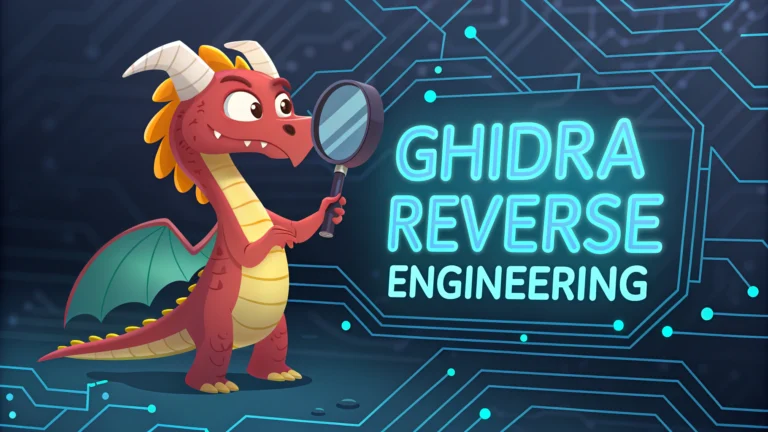Ghidra, developed by the NSA and released as open-source software in 2019, stands as one of the most powerful reverse engineering tools available to security professionals.
This quick guide explores how to use Ghidra effectively for penetration testing and malware analysis.
Getting Started with Ghidra
Download Ghidra from the official NSA GitHub repository: https://github.com/NationalSecurityAgency/ghidra
System Requirements:
- Java Development Kit (JDK) 11 or later
- 4GB RAM minimum (8GB recommended)
- 1GB disk space
- Supported OS: Windows, Linux, macOS
Key Features for Penetration Testing
- Disassembly and decompilation of multiple architectures
- Multi-user collaboration support
- Python scripting API
- Cross-references tracking
- Custom annotation capabilities
Basic Workflow
- Create a new project (File → New Project)
- Import binary file (File → Import File)
- Analyze the code (Auto-analysis will start automatically)
- Navigate through functions in the Symbol Tree
- Use the decompiler to view C-like code
Tips for Effective Analysis
- Use bookmarks to mark points of interest
- Enable the Bytes view to see raw binary data
- Utilize the Data Type Manager for custom structures
- Apply labels to improve code readability
Advanced Features
The Script Manager (Window → Script Manager) allows automation of repetitive tasks through Python or Java scripts.
Common Scripts for Pen Testing:
- FindCrypt – identifies cryptographic constants
- String searcher – locates specific strings in binary
- Function analyzer – identifies similar functions
Practical Applications
Binary analysis helps identify vulnerabilities like buffer overflows, format string vulnerabilities, and logic flaws.
Common Use Cases:
- Malware analysis and reverse engineering
- Vulnerability research in closed-source applications
- Firmware analysis for IoT devices
- Software protection assessment
Best Practices
- Always work on copies of binary files
- Document findings using comments and bookmarks
- Export analysis results regularly
- Use version control for collaborative projects
Additional Resources
- Official Ghidra Documentation: https://ghidra-sre.org/CheatSheet.html
- NSA Ghidra Training Materials: https://github.com/NationalSecurityAgency/ghidra/tree/master/GhidraDocs/GhidraClass
- Community Scripts Repository: https://github.com/ghidraninja/ghidra_scripts
Performance Optimization
Memory Management
- Increase Java heap size for large binaries
- Close unused projects and windows
- Clear analysis cache periodically
- Use project compression for storage efficiency
Troubleshooting Common Issues
Analysis Problems
- Incorrect function detection – manually define function boundaries
- Missing symbols – import external libraries
- Decompilation errors – adjust analysis options
- Memory errors – increase Java heap allocation
Integration with Other Tools
Ghidra can be integrated with:
- IDA Pro importers/exporters
- Binary Ninja bridges
- Custom forensics frameworks
- Version control systems
Security Considerations
When Using Ghidra
- Always analyze malware in isolated environments
- Verify file hashes before analysis
- Keep Ghidra updated for security patches
- Use access controls for shared projects
Conclusion
Ghidra provides a robust platform for reverse engineering and security analysis. Its open-source nature, extensive feature set, and active community make it an invaluable tool for security professionals. Regular practice and exploration of advanced features will enhance analysis capabilities and efficiency.
Future Development
- Community-driven feature expansion
- Enhanced automation capabilities
- Improved analysis algorithms
- Better integration with modern development tools
FAQs
- What is Ghidra and who developed it?
Ghidra is a free and open-source software reverse engineering (SRE) framework developed by the National Security Agency (NSA). It was publicly released in 2019 and includes a suite of tools for analyzing compiled code. - What programming languages does Ghidra support for decompilation?
Ghidra supports decompilation of multiple programming languages including C, C++, Assembly, Java, Python, and various other compiled languages. It can analyze code for multiple processor architectures like x86, ARM, MIPS, and PowerPC. - How does Ghidra’s decompiler differ from other reverse engineering tools?
Ghidra’s decompiler produces high-quality pseudocode output and includes advanced features like data type recovery, function signature analysis, and cross-references. It also provides collaborative features allowing multiple analysts to work on the same project. - Can Ghidra be used for malware analysis?
Yes, Ghidra is commonly used for malware analysis. It can help analysts understand malicious code behavior, identify malware signatures, and analyze potential threats by decompiling suspicious executables and studying their functionality. - What are Ghidra’s key features for penetration testing?
Ghidra provides binary analysis capabilities, function graphing, script development in Python/Java, data flow analysis, and patch analysis. These features help pentesters understand application vulnerabilities and security weaknesses. - How can I extend Ghidra’s functionality?
Ghidra can be extended through its scripting interface using Java or Python. Users can create custom scripts and plugins to automate analysis tasks, add new features, or integrate with other security tools. - What are the system requirements to run Ghidra effectively?
Ghidra requires Java Development Kit (JDK) 11 or later, minimum 4GB RAM (8GB+ recommended), and runs on Windows, Linux, or macOS. A multi-core processor is recommended for optimal performance. - How does Ghidra handle encrypted or obfuscated code?
Ghidra includes tools for analyzing encrypted and obfuscated code, including entropy analysis, byte pattern matching, and string discovery. However, additional manual analysis and custom scripts may be needed for heavily obfuscated code. - What are Ghidra’s limitations compared to commercial reverse engineering tools?
Ghidra may have slower performance on large binaries, lacks some debugging capabilities found in commercial tools, and has limited support for certain newer processor architectures and file formats. - How secure is Ghidra for analyzing potentially malicious code?
While Ghidra includes security features, it’s recommended to run it in an isolated environment (like a virtual machine) when analyzing suspicious files to prevent potential exploitation of vulnerabilities.







